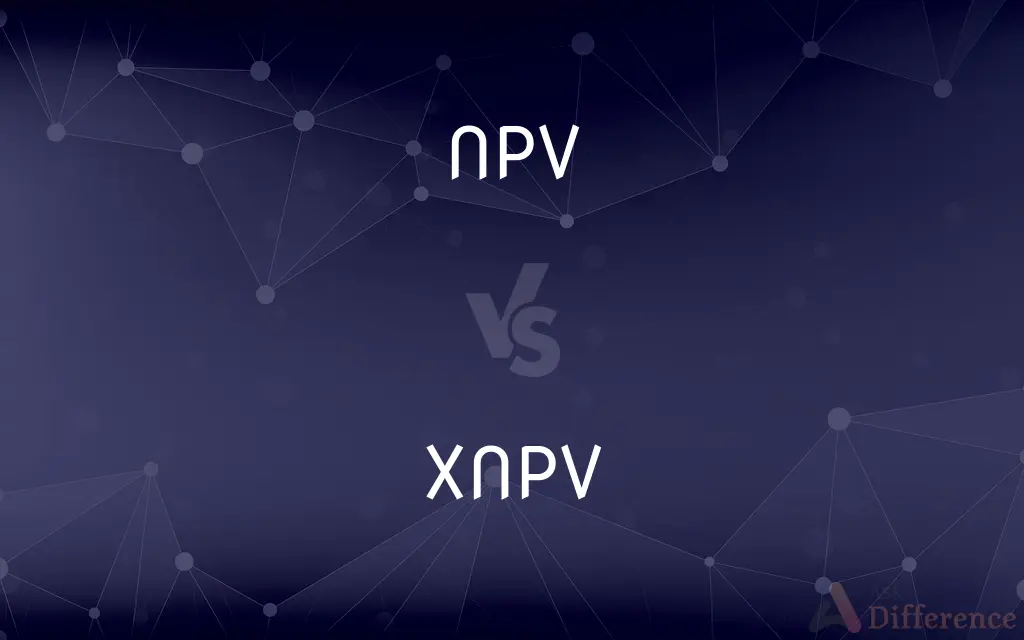NPV vs. XNPV — What's the Difference?
By Tayyaba Rehman — Published on December 7, 2023
NPV calculates the net present value using even time intervals. XNPV calculates it with specific dates, allowing for irregular intervals.

Difference Between NPV and XNPV
Table of Contents
ADVERTISEMENT
Key Differences
Understanding the Basics: NPV, or Net Present Value, is a financial metric used to determine the value today of future cash flows. XNPV, on the other hand, is an extension of NPV, incorporating specific dates, making it ideal for scenarios with irregular cash flow intervals.
Time Intervals Consideration: While NPV assumes cash flows happen at regular intervals (e.g., annually, monthly), XNPV takes into account the exact dates of cash flows. This differentiation allows XNPV to be more accurate in situations where the timing between cash flows varies.
Applications in Real World: In investment projects where cash flows are expected to occur at consistent intervals, NPV would be a suitable metric. However, in projects like construction or R&D, where cash flows can be sporadic, XNPV offers a clearer financial picture.
Software & Usage: Many financial software tools and spreadsheet applications, such as Microsoft Excel, provide functions for both NPV and XNPV. While the NPV function requires a discount rate and a series of cash flows, the XNPV function additionally requires specific dates associated with each cash flow.
Decision Making: In finance, both NPV and XNPV serve as tools to aid decision-making. Positive values indicate a potentially good investment, while negative values suggest the opposite. But, XNPV's inclusion of specific dates can lead to a more precise valuation in certain scenarios.
ADVERTISEMENT
Comparison Chart
Definition
Net Present Value
Net Present Value with Specific Dates
Time Intervals
Assumes regular intervals
Uses exact dates, allowing for irregular intervals
Application Scenarios
Suitable for regular cash flow intervals
Ideal for sporadic or irregular cash flows
Input Requirements
Discount rate and series of cash flows
Discount rate, series of cash flows, and associated dates
Precision
Provides a general financial picture
Offers a more precise valuation due to specific date consideration
Compare with Definitions
NPV
A financial metric evaluating the present value of future cash flows.
The NPV of our project indicates a positive return on investment.
XNPV
Used when cash flows occur at irregular intervals.
For our construction project with varied payment schedules, XNPV is more appropriate.
NPV
An indicator of how much an investment is worth in today's dollars.
Based on the NPV, we can ascertain the project's potential profitability.
XNPV
A financial metric similar to NPV but factors in specific cash flow dates.
The XNPV gives us a detailed financial picture due to its date-specific calculations.
NPV
Used to determine the profitability of an investment or project.
A positive NPV suggests that the project could be a good financial decision.
XNPV
Specially tailored for situations with inconsistent cash flow intervals.
For projects with irregular income streams, XNPV is the go-to financial metric.
NPV
A tool to compare the initial investment against the present value of expected future earnings.
If the NPV exceeds our initial costs, the venture seems promising.
XNPV
Offers a more precise valuation by incorporating exact cash flow timings.
Given the sporadic nature of our revenues, the XNPV provides a clearer insight.
NPV
Represents the difference between the initial outlay and the present value of future cash flows.
The higher the NPV, the more lucrative the project appears.
XNPV
Extends the traditional NPV by integrating specific date information.
XNPV's inclusion of exact dates refines our investment evaluation process.
Common Curiosities
How does XNPV account for specific dates?
XNPV requires the user to input specific dates corresponding to each cash flow.
What do NPV and XNPV stand for?
NPV stands for "Net Present Value," while XNPV stands for "Net Present Value with Specific Dates."
Are NPV and XNPV used for evaluating investments?
Yes, both are used to evaluate the potential profitability of investments or projects.
How do NPV and XNPV factor in the time value of money?
Both discount future cash flows back to the present, considering money's diminished future value.
When would one use NPV over XNPV?
NPV is used for regular cash flow intervals, while XNPV is for irregular or specific-date intervals.
Is a positive NPV or XNPV always indicative of a good investment?
Generally, a positive value suggests potential profitability, but other factors should also be considered.
Can negative values for NPV or XNPV arise?
Yes, negative values suggest the project might not return the expected value in today's dollars.
How do NPV and XNPV help in decision-making?
They provide a financial metric to assess potential returns compared to initial investments.
Can NPV and XNPV values differ for the same project?
Yes, due to the consideration of exact dates in XNPV, the values can differ.
Are there software tools available for NPV and XNPV calculations?
Yes, many financial software and spreadsheet applications offer NPV and XNPV functions.
Which is more accurate: NPV or XNPV?
XNPV can be more accurate for projects with irregular cash flow dates.
Does XNPV consider weekends and holidays in its calculations?
No, XNPV simply uses the exact dates provided, regardless of weekends or holidays.
Can XNPV be used for regular cash flow intervals like NPV?
Yes, but XNPV's main advantage is its capability to handle irregular intervals.
In what financial fields are NPV and XNPV predominantly used?
They're widely used in capital budgeting, investment appraisal, and corporate finance.
How important are discount rates in NPV and XNPV calculations?
Very important. The discount rate reflects the desired return on investment.
Share Your Discovery

Previous Comparison
Pet Animals vs. Domestic Animals
Next Comparison
Rebonding vs. SmoothingAuthor Spotlight
Written by
Tayyaba RehmanTayyaba Rehman is a distinguished writer, currently serving as a primary contributor to askdifference.com. As a researcher in semantics and etymology, Tayyaba's passion for the complexity of languages and their distinctions has found a perfect home on the platform. Tayyaba delves into the intricacies of language, distinguishing between commonly confused words and phrases, thereby providing clarity for readers worldwide.
















































